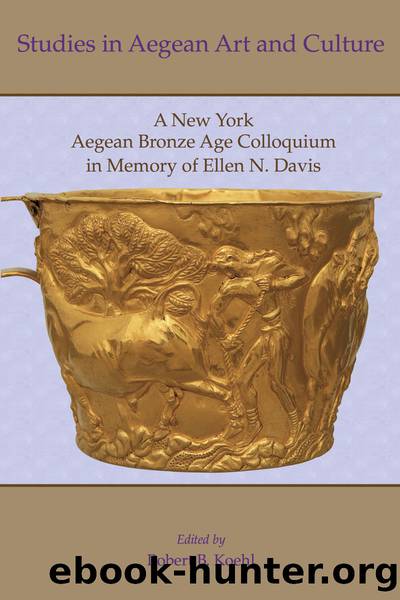Studies in Aegean Art and Culture by Robert B. Koehl;

Author:Robert B. Koehl;
Language: eng
Format: epub
Tags: HISTORY / Ancient / General
Publisher: Casemate Publishers & Book Distributors, LLC
Published: 2019-05-30T00:00:00+00:00
Figure 7.2. Middle Minoan III pottery with landscape scenes: (a) Kommos (C 2376), Herakleion Archaeological Museum; (b) Knossos (Betancourt 1985, pl. 12:I), Ashmolean Museum; (c) Phaistos (F. 4491), Herakleion Archaeological Museum; (d) Phaistos (F. 5599), Herakleion Archaeological Museum; Shank 2001, fig. 1.
Around the same time, or slightly later, in MM III/LM I, seals be gin to show river scenes with water, animals, and river plants growing from their banks (Krzyszkowska 2005, figs. 258â261). On two seals from Knossos (Krzyszkowska 2005, figs. 258, 261), water is depicted in small, parallel curving segments, which help to convey a sense of movement. On these two seals, the water serves as a type of groundline upon which geese and nautili respectively sit. When water is part of a floral landscape (Krzyszkowska 2005, fig. 259), the plantâs stem, in this case a flowering papyrus, becomes the groundline, with the water depicted below as short, parallel, diagonal marks, and a pair of geese above.
The earliest miniature Aegean wall paintings on which water can positively be identified are friezes from Hagia Eirene, Kea, and Akrotiri, Thera, dated to LM/Late Cycladic (LC) I. The fragments from Hagia Eirene, which belong to a large room in the Northeast Bastion of the town, depict landscapes, boats in the sea by a town, and activities on the shore (Abramowitz-Coleman 1970; 1973; Abramowitz 1980; Morgan 1990; 1998; Morgan, ed., 2005, 31, figs. 1.17, 1.18, pl. 15.2:1). Some fragments may depict the actual view visible from the windows of the bastion overlooking the harbor, whose boats are decorated with dolphins and festive bunting and appear to bob on the water (Fig. 7.3). Indeed, small, non-joining fresco fragments positioned near one boat have added white paint on the blue sea, presumably to show sea-foam or the white-capped crests of waves. In either case, the movement of water is deliberately rendered. On the shore, at least one large building rises from the groundline. Men walk along the coast; some carry cauldrons. While its theme of a group event, including men transporting large vessels, has parallels with the miniature paintings from the inland site of Tylissos (Shaw 1972, fig. 13), at the coastal site of Hagia Eirene the setting also includes images of water.
Figure 7.3. Reconstruction of a boat, the sea, a building, and male figures, Hagia Eirene (Morgan 2013, fig. 1). Courtesy L. Morgan.
Download
This site does not store any files on its server. We only index and link to content provided by other sites. Please contact the content providers to delete copyright contents if any and email us, we'll remove relevant links or contents immediately.
The Art of Boudoir Photography: How to Create Stunning Photographs of Women by Christa Meola(18545)
Red Sparrow by Jason Matthews(5392)
Harry Potter 02 & The Chamber Of Secrets (Illustrated) by J.K. Rowling(3627)
In a Sunburned Country by Bill Bryson(3486)
Drawing Cutting Edge Anatomy by Christopher Hart(3454)
Figure Drawing for Artists by Steve Huston(3385)
Harry Potter and the Prisoner of Azkaban (Book 3) by J. K. Rowling(3304)
The Daily Stoic by Holiday Ryan & Hanselman Stephen(3239)
Japanese Design by Patricia J. Graham(3113)
The Roots of Romanticism (Second Edition) by Berlin Isaiah Hardy Henry Gray John(2878)
Make Comics Like the Pros by Greg Pak(2857)
Stacked Decks by The Rotenberg Collection(2812)
Draw-A-Saurus by James Silvani(2658)
Harry Potter and the Deathly Hallows (7) by J.K. Rowling(2648)
Tattoo Art by Doralba Picerno(2601)
On Photography by Susan Sontag(2578)
Churchill by Paul Johnson(2512)
The Daily Stoic by Ryan Holiday & Stephen Hanselman(2466)
Drawing and Painting Birds by Tim Wootton(2441)
